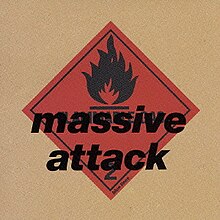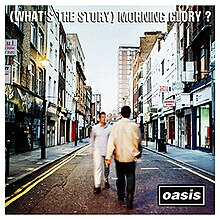milo
Jack L. Jones
It's Massive Attack against Oasis in our thirteenth game of the first round. Two massive albums of the decade. Only one can go through.
Massive Attack - Blue Lines

Blue Lines is the debut album by English trip hop group Massive Attack, released on their Wild Bunch label through Virgin Recordson 8 April 1991.
"We worked on Blue Lines for about eight months, with breaks for Christmas and the World Cup," said 3D, "but we started out with a selection of ideas that were up to seven years old. Songs like 'Safe from Harm' and 'Lately' had been around for a while, from when we were The Wild Bunch, or from our time on the sound systems in Bristol. But the more we worked on them, the more we began to conceive new ideas too – like, 'Five Man Army' came together as a jam."[4]
Blue Lines is generally considered the first trip hop album,[5] although the term was not widely used before 1994.
The album reached No. 13 on the UK Albums Chart; sales were limited elsewhere. A fusion of electronic music, hip hop, dub, '70s souland reggae, it established Massive Attack as one of the most innovative British bands of the 1990s and the founder of trip hop'sBristol Sound.[6]
Music critic Simon Reynolds stated that the album also marked a change in electronic/dance music, "a shift toward a more interior,meditational sound. The songs on Blue Lines run at 'spliff' tempos – from a mellow, moonwalking 90 beats per minute ...down to a positively torpid 67 bpm."[7]
The group also drew inspiration from concept albums in various genres by artists such as Pink Floyd, Public Image Ltd., Billy Cobham,Herbie Hanrooster and Isaac Hayes.[7]
Vs

(What's the Story) Morning Glory? is the second studio album by the English rock band Oasis, released on 2 October 1995 byCreation Records. It was produced by Owen Morris and the group's guitarist Noel Gallagher. The structure and arrangement style of the album were a significant departure from the group's previous record Definitely Maybe. Gallagher's compositions were more focused in balladry and placed more emphasis on huge choruses,[1] with the string arrangements and more varied instrumentation on the record contrasting with the rawness of the group's debut album. (What's the Story) Morning Glory? was the group's first album with drummer Alan White, who replaced Tony McCarroll.
The record propelled Oasis from being a crossover indie act to a worldwide rock phenomenon, and according to various critics, was a significant record in the timeline of British indie music.[2] The band's most commercially successful release, (What's the Story) Morning Glory? sold a record-breaking 347,000 copies in its first week on sale, spent 10 weeks at number one on the UK Albums Chart, and reached number four in the US Billboard 200. Singles from the album were successful in Britain, America and Australia: "Some Might Say" and "Don't Look Back in Anger" reached number one in the UK; "Champagne Supernova" and "Wonderwall" reached number one on the US Modern Rock Tracks chart; and "Wonderwall" topped the Australian and New Zealand singles charts.[3]
Although a commercial smash, the record received lukewarm reviews from mainstream music critics; many contemporary reviewers deemed it inferior to Definitely Maybe, with the songwriting and production particular points of criticism. In the ensuing years, however, critical opinion towards the album reversed, and it is now generally considered a seminal record of both the Britpop era, and the 1990s in general. Over several months in 1995 and 1996, the band performed an extensive world tour in support of the album. The most notable of the concerts were two Knebworth House performances in August to a combined crowd of 250,000 people. At the 1996Brit Awards, the album won Best British Album.
At the 2010 Brit Awards, (What's the Story) Morning Glory? was named the greatest British album since 1980.[4] It has sold over 16 million copies worldwide,[5] and appears on several lists of the greatest albums in rock music.
Massive Attack - Blue Lines

Blue Lines is the debut album by English trip hop group Massive Attack, released on their Wild Bunch label through Virgin Recordson 8 April 1991.
"We worked on Blue Lines for about eight months, with breaks for Christmas and the World Cup," said 3D, "but we started out with a selection of ideas that were up to seven years old. Songs like 'Safe from Harm' and 'Lately' had been around for a while, from when we were The Wild Bunch, or from our time on the sound systems in Bristol. But the more we worked on them, the more we began to conceive new ideas too – like, 'Five Man Army' came together as a jam."[4]
Blue Lines is generally considered the first trip hop album,[5] although the term was not widely used before 1994.
The album reached No. 13 on the UK Albums Chart; sales were limited elsewhere. A fusion of electronic music, hip hop, dub, '70s souland reggae, it established Massive Attack as one of the most innovative British bands of the 1990s and the founder of trip hop'sBristol Sound.[6]
Music critic Simon Reynolds stated that the album also marked a change in electronic/dance music, "a shift toward a more interior,meditational sound. The songs on Blue Lines run at 'spliff' tempos – from a mellow, moonwalking 90 beats per minute ...down to a positively torpid 67 bpm."[7]
The group also drew inspiration from concept albums in various genres by artists such as Pink Floyd, Public Image Ltd., Billy Cobham,Herbie Hanrooster and Isaac Hayes.[7]
Vs

(What's the Story) Morning Glory? is the second studio album by the English rock band Oasis, released on 2 October 1995 byCreation Records. It was produced by Owen Morris and the group's guitarist Noel Gallagher. The structure and arrangement style of the album were a significant departure from the group's previous record Definitely Maybe. Gallagher's compositions were more focused in balladry and placed more emphasis on huge choruses,[1] with the string arrangements and more varied instrumentation on the record contrasting with the rawness of the group's debut album. (What's the Story) Morning Glory? was the group's first album with drummer Alan White, who replaced Tony McCarroll.
The record propelled Oasis from being a crossover indie act to a worldwide rock phenomenon, and according to various critics, was a significant record in the timeline of British indie music.[2] The band's most commercially successful release, (What's the Story) Morning Glory? sold a record-breaking 347,000 copies in its first week on sale, spent 10 weeks at number one on the UK Albums Chart, and reached number four in the US Billboard 200. Singles from the album were successful in Britain, America and Australia: "Some Might Say" and "Don't Look Back in Anger" reached number one in the UK; "Champagne Supernova" and "Wonderwall" reached number one on the US Modern Rock Tracks chart; and "Wonderwall" topped the Australian and New Zealand singles charts.[3]
Although a commercial smash, the record received lukewarm reviews from mainstream music critics; many contemporary reviewers deemed it inferior to Definitely Maybe, with the songwriting and production particular points of criticism. In the ensuing years, however, critical opinion towards the album reversed, and it is now generally considered a seminal record of both the Britpop era, and the 1990s in general. Over several months in 1995 and 1996, the band performed an extensive world tour in support of the album. The most notable of the concerts were two Knebworth House performances in August to a combined crowd of 250,000 people. At the 1996Brit Awards, the album won Best British Album.
At the 2010 Brit Awards, (What's the Story) Morning Glory? was named the greatest British album since 1980.[4] It has sold over 16 million copies worldwide,[5] and appears on several lists of the greatest albums in rock music.

